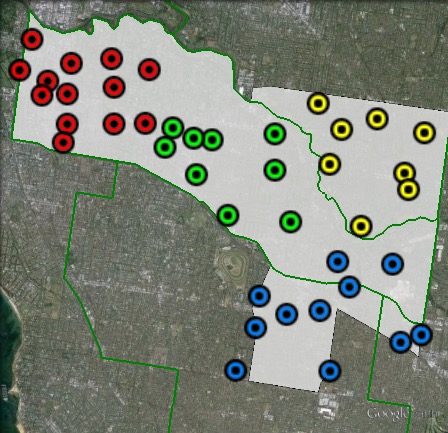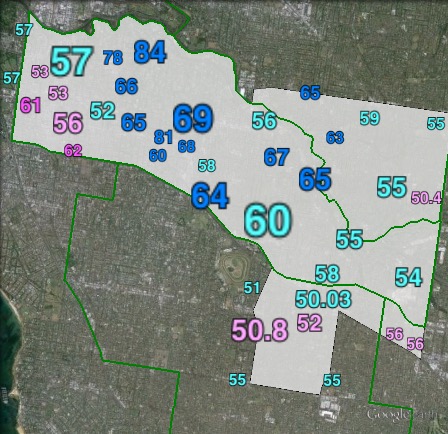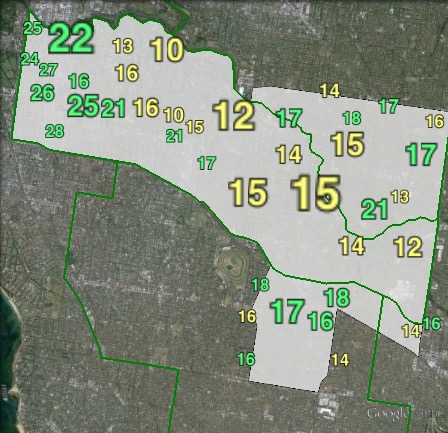LIB 9.9%
Incumbent MP
Kelly O’Dwyer, since 2009.
Geography
Higgins covers suburbs in the inner south-east of Melbourne. Its suburbs include South Yarra, Prahran, Toorak, Carnegie, Malvern and Glen Iris. Most of the seat is covered by Stonnington LGA, as well as southern parts of Boroondara LGA and small parts of Glen Eira and Monash LGAs.
History
Higgins was first created in 1949 when the Parliament was expanded in size. Its first member was Harold Holt, who had previously been Member for Fawkner in the same part of Melbourne. Holt was a minister in the Menzies United Australia Party government at the beginning of the Second World War.
Holt returned to the ministry in 1949 as Minister for Immigration. He became Menzies’ Treasurer in 1958 and became Prime Minister upon Menzies’ retirement in 1966.
Holt disappeared in sensational circumstances in December 1967 while swimming at Cheviot Beach in Victoria. Higgins was won by new Prime Minister John Gorton in a 1968 by-election. Gorton had previously been a Senator and was required to move to the House of Representatives.
Gorton held the seat continously until the 1975 election. Following Malcolm Fraser’s accession to the Liberal leadership Gorton resigned from the Liberal Party and sat as an independent. At the 1975 election he stood for an ACT Senate seat and Higgins returned to the Liberal Party.
Roger Shipton won the seat in 1975 and maintained his hold on the seat until 1990, when he was challenged for preselection by Peter Costello. Costello held the seat from 1990 until his 2009 resignation, triggering a by-election.
The ensuing by-election became a contest between the Liberal Party’s Kelly O’Dwyer and the Greens candidate, prominent academic Clive Hamilton, as the ALP refused to stand a candidate. O’Dwyer won the seat comfortably, and was re-elected in 2010, and again in 2013. She now serves as Assistant Treasurer in the Turnbull government.
Candidates
- Rebecca O’Brien (Australian Equality Party)
- Jessica Tregear (Derryn Hinch’s Justice Party)
- Kelly O’Dwyer (Liberal)
- Jason Ball (Greens)
- Robert Kennedy (Liberal Democrats)
- Carl Katter (Labor)
- Nancy Bassett (Nick Xenophon Team)
- Eleonora Gullone (Animal Justice)
Assessment
Higgins on paper is not a very interesting seat – the Liberal Party polled a majority of the primary vote, and Labor trails by about 10% after preferences.
Higgins will almost certainly stay with the Liberal Party, but could become a lot more interesting. The Greens have preselected high-profile candidate and appear to be paying a lot of attention to the seat, which overlaps with the state seat of Prahran, which the Greens won off the Liberal Party in 2014. It’s plausible that the Greens could overtake Labor, and if they can do this while also taking some Liberal votes they could make Higgins the first federal Liberal/Greens marginal seat.
Polls
- 53% to Liberal – Lonergan commissioned by the Greens, 3-4 June 2016
2013 result
| Candidate | Party | Votes | % | Swing |
| Kelly O’Dwyer | Liberal | 47,467 | 54.4 | +3.9 |
| Wesa Chau | Labor | 21,027 | 24.1 | -5.2 |
| James Harrison | Greens | 14,669 | 16.8 | -1.0 |
| Graeme B Weber | Independent | 1,663 | 1.9 | +1.9 |
| Phillip Leslie Dall | Palmer United Party | 1,385 | 1.6 | +1.6 |
| Jamie Baldwin | Family First | 742 | 0.9 | -0.2 |
| Leanne Price | Rise Up Australia | 354 | 0.4 | +0.4 |
| Informal | 3,239 | 3.7 |
2013 two-party-preferred result
| Candidate | Party | Votes | % | Swing |
| Kelly O’Dwyer | Liberal | 52,323 | 59.9 | +4.5 |
| Wesa Chau | Labor | 34,984 | 40.1 | -4.5 |

Booth breakdown
Booths have been divided into four areas:
- Central – Malvern.
- North-East – Burwood, Glen Iris.
- South-East – Carnegie, Chadstone.
- West – Hawksburn, Prahran, South Yarra, Toorak.
The Liberal Party topped the primary vote in all four areas, winning a majority of the primary vote in three areas. Their primary vote ranged from 46% in the south-east to 59% in the centre.
Labor came second in all four areas, with a vote ranging from 22% in the centre to 33% in the south-east.
The Greens vote ranged from 15% in the centre and south-east to 20% in the west.
| Voter group | LIB % | ALP % | GRN % | Total votes | % of votes |
| Central | 58.9 | 21.9 | 14.8 | 14,603 | 16.7 |
| North-East | 53.6 | 25.1 | 16.7 | 10,317 | 11.8 |
| South-East | 46.3 | 32.9 | 15.4 | 11,982 | 13.7 |
| West | 51.4 | 24.7 | 20.0 | 17,628 | 20.2 |
| Other votes | 57.1 | 21.2 | 16.5 | 32,777 | 37.5 |




I think there’s just a different split in demographics in Melbourne compared to Sydney. Sydney’s harbour and expensive property prices means that there will always be affluent and conservative pockets in Grayndler and Sydney that are less likely to vote Green.
In Melbourne, it’s much more of a north vs south dynamic, with most of the “Inner city Liberal” vote concentrated south of the river (basically, on the waterfront and hills). So at the moment there’s much less of a bar to clear for the Greens in Melbourne, Batman, Wills, and (soon) Gellibrand. Although in the longer-term, I would expect the Lib vote in Melbourne and Gellibrand to improve significantly.
This is a seat where Turnbull returning to power would have blunted any anti Liberal swing. Going for the educated/professional vote is a reasonable approach for the Greens. Greens look set to become the 2nd party in affluent areas in general, even if they’re fighting over a miniscule residue of the vote. In seats that also have strong left leaning pockets (eg Prahran in Higgins, the area around UQ in Ryan) they are right to keep trying.
Even if Greens lose appeal due to the potential influence on minor parties on the upcoming government, it’s worth pointing out that they trounced Labor in Higgins, and they’d only need to stay ahead by a little bit to be the 2nd party. Any flavour of bad Liberal government could make this seat winnable for the Greens. In every other blue ribbon seat Labor is edging ahead of Greens on first preferences (wait and see how it ends up with minors).
The final 2PP looks like it has washed out around 58-42, probably will increase slightly as declaration votes are added in.
O’Dwyer got a mild swing against her in the affluent western and central parts of the seat, however she actually did better than 2013 in the east. This probably reflects the increasing affluence of areas like Murrumbeena and Hughesdale, as well as them being less Green-friendly than the inner city parts of the seat.
As a final comment, I note that the much-ridiculed Morgan actually got this one fairly right. The over-estimated Labor and under-estimated Greens, but the Liberal primary was very close to the final result, and they correct in noting that almost all of the Greens increase would just come from Labor.
A broken clock is right twice a day….
Yes MM, Sydney’s demographics are very different in both its rich inner ring, and its multi-ethnic areas – generally the middle ring and outer suburbs. The Greens have little support in multi-cultural Sydney, and its been declining for a while. Given that immigration will continue (apparently not if Turnbull needs Bob Katter’s vote!), that should be a concern for the Greens.
Agree rich people are the future for the Greens, Daniel. In Sydney also, for a while now they come (a distant to the Libs) second in a whole swag of affluent northern and waterfront areas in front of Labor, especially apparent in State electorates. I don’t think the NSW party knows quite what to do about that – they seem just embarrassed. Some derisively call their own voters “Liberals with bicycles”. Whenever it’s raised even in polite discussion, they react with anger.
Below is a post that should go to Grayndler’s thread (and I will put it there) – but is relevant to anyone interested in voter demographics and the future of the Greens – in Melbourne and elsewhere.
Sydney vs Melbourne pt 2
In Grayndler and especially Sydney – which is been transformed by apartment construction (and soon Green Square), gentrification has been stratospheric over the last decade. The Greens heartland has become a very different place to what it was 20 years ago when they rose as a force. Apartment buyers, tax lawyers and stockbrokers don’t vote the same way as pro-bono refugee activists, students and graphic designers.
Most of my Sydney and Grayndler friends, colleagues and even family vote Greens (yes they are mostly white, comfortably off, professional), but some didn’t this time. They gave varied reasons – one didn’t like DiNatale. Some saw them as part of the “establishment” now (they’ve had power here for over two decades, so that’s true). Others, alarmed by the perceived threat to cuddly Albo and Tanya, or just hopeful of a change of government, decided to strategically vote Labor.
If that last case was a significant factor – the Greens very visible big spending campaign and their overconfidence had a perverse affect – it drove voters away.
@HG McGuffin sad to hear that re NSW Greens and affluent areas. Jason Ball seemed very at ease in Higgins, even the Malvern parts. Greens should try putting forth candidates with academic or professional credentials in North Shore/Northern Beaches seats in both 2019 elections, especially if the respective Liberal governments are on the nose. Intellectuals can still pull off being “anti establishment” when government policy is at odds with their fields of expertise.
Even if they truly figure out how to convert Liberal voters Higgins will be very tough. The Greens’ best bet is to figure out how to get Prahran and St Kilda in the same seat.
^ The AEC actually proposed putting Prahran and St Kilda together at the last redistribution. I personally supported that, but it got so many objections that they reversed it. Perhaps it will be tried again this time.